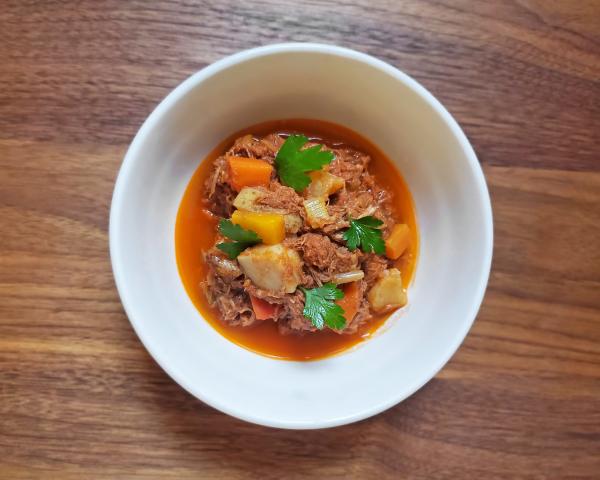I am looking forward to making the Stew. Thanks for all the work you do that is so important. And thank you for your work with June at AKV. Paddy (Wade)
Beef Paprikash
Recipe and words by Chef Veronica Bartolacci.
Growing up, my family didn’t have a lot of money, so recipes that were inexpensive to make and filling were something my mother was always on the lookout for. This is one of those recipes. It was a favorite winter dinner of my childhood — so much so that my mom would always have a huge pot of it ready for the moment I walked in the door for visits home over college breaks. To me, this meal means cozy warm nights by the fire, love, warmth, and security.
This stew can be put into a crockpot in the morning, and it will be ready by dinner time. Use whatever root vegetables are on hand or available from your local farmer — it will taste wonderful. My mom always served it with soft buttered bread for dipping.
Make this stew yourself, or pick it up curbside from our Farm Store & Welcome Center (available as a rotational, heat-and-eat menu option)!
Beef Paprikash
Ingredients
- 2 lb stew beef (cut into cubes)
- 3 celery stalks
- 2 yellow onions
- 3 large carrots
- 1 russet potato
- 2 daikon turnips
- 2 gilfeather turnips (Vermont’s state vegetable!)
- 2 x 14 oz can tomato sauce, plain or spiced
- 16 oz beef broth
- 3 bay leaves
- 1/4 C sweet paprika
- 1/4 C red wine
- 3 Tbsp Worcestershire sauce
- Salt and pepper to taste
Method
- Chop all vegetables into ½ inch pieces.
- Combine the carrots, celery, onions and a couple pinches of salt into a large pot and sweat (steam on a medium-low heat with the lid on).
- Once the vegetables become translucent, add the bay leaves and paprika. Cook for a few minutes, stirring occasionally.
- Add the red wine and the worcestershire sauce and cook for a few more minutes to cook off the alcohol.
- Add the rest of the ingredients and turn heat up until it comes to a boil.
- Once at a boil, reduce heat to low and let simmer for 3 hours, stirring occasionally so the bottom doesn't burn.
- Feel free to add water at this point if it is too thick of a stew for your liking.
If you do have a crock pot, just add all the ingredients into the pot and set to low for 12-14 hours. Enjoy!
Comments
Should I brown the stew meat first, set aside, then cook veggies in the same pot. Add meat in step #4?. Thanks, C
Hi Carol, thanks for your question! Veronica says she doesn't typically brown the meat beforehand, but does allow it cook and break down in the stew for a couple hours. You can easily brown it a little before hand though if you prefer.
Made this stew last evening. Was initially worried that I should brown the beef in advance, but "went with it", and followed the directions and allowed for the 3 hour simmer stipulated in Step #6. It was very tender and easy to chew on. Loved all the vegetables in this recipe, and the strong dose of Hungarian paprika that made the meal very flavorful. Reminded me of traveling in Romania about 20 years ago, every restaurant table has three items on it salt, pepper and paprika. It is a staple of the Romanian diet, especially north of the Carpathian Mountains, which has a heavy Hungarian influence dating back to the Hapsburg Empire days.
,
Would love to grow some of the gilfeather turnips this summer in our garden, but I need to find a place from which to source them.
I look forward to trying this recipe again in the "all day" crock pot.
Highly recommend this as a winter staple. I may try it with chicken at some point.
Many thanks to Chef Veronica Bartolacci!! Very easy to prepare, and easy to add extra veggies if you wish.
Years ago I used to grow the delicious Vermont Gilfeather turnip for an heirloom demonstration garden at the Kent Museum in Calais, VT. I sourced the seeds for them, along with other wonderful heirloom varieties, from Cornell University.
